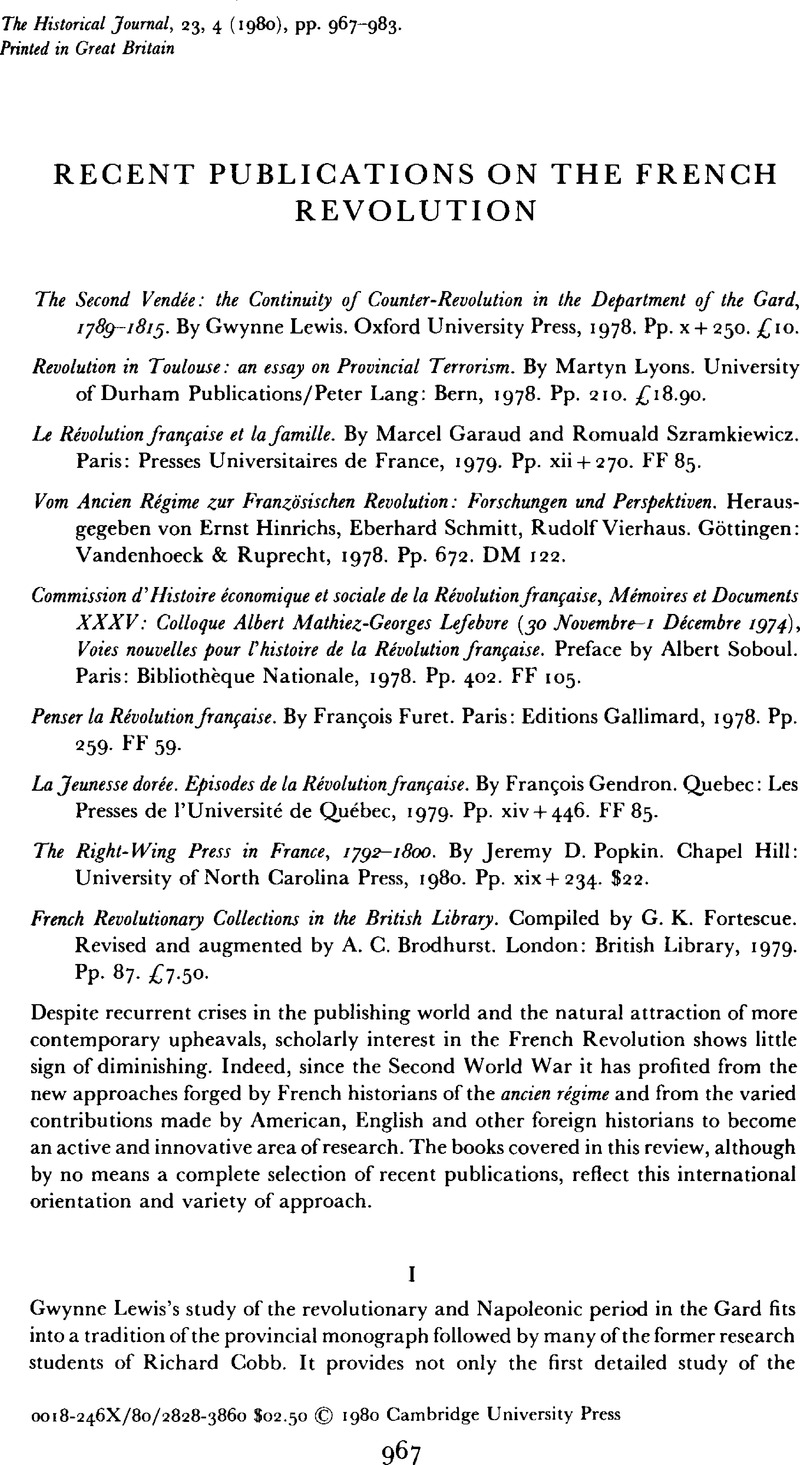No CrossRef data available.
Article contents
Recent Publications on the French Revolution
Published online by Cambridge University Press: 11 February 2009
Abstract

- Type
- Review Articles
- Information
- Copyright
- Copyright © Cambridge University Press 1980
References
1 Huard, Raymond, ‘Le préhistoire des partis. Le parti républicain dans le Gard de 1848 à 1881’, le Mouvement Social, no. 107 (avril–juin 1979), 4Google Scholar.
2 Several articles by the American historian James N. Hood supplement Lewis's interpretation. See in particular ‘Protestant–catholicrelations and the roots of the first popular counter-revolutionary movement in France’, Journal of Modern History, XLIII (1971), 245–75Google Scholar; ‘Patterns of popular protest in the French Revolution: the conceptual contribution of the Gard’ ibid, XLVIII (1976), 259–93; ‘Permanence des conflits traditionnels sous la Révolution: l'exemple du Gard’, Revue d'histoire moderne et contemporaine, XXIV (1977), 602–40Google Scholar; ‘Revival and mutation of old rivalries in revolutionary France’, Past & Present, LXXXII (02 1979), 82–115Google Scholar.
3 Forster, R., The nobility of Toulouse in the eighteenth century: a social and economic study (Baltimore,1960)Google Scholar; Higgs, D., Ultraroyalism in Toulouse: from its origins to the revolution of 1830 (Baltimore, 1973)Google Scholar; Berlanstein, Leonard R., The barristers of Toulouse in the eighteenth century (1740–1793) (Baltimore,1975)Google Scholar; Beyssi, J.,‘Leparti jacobin à Toulouse sous le Directoire’ Annaleshisloriques de la Révolution française CXVII–CXVIII (1950),28–54 and 109–33Google Scholar; M. T. Lagasquie, ‘Recherches sur le personnel terroriste toulousain’, ibid. no. 204 (1971), 248–64; M. Schlumberger, ‘La réaction thermidorienne à Toulouse, ibid. pp. 265–83; Sentou, J.,Fortunes et groupes sociaux à Toulouse sous la révolution (1789–1799): essai d'histoire statistique (Toulouse, 1969)Google Scholar.
4 Alan Forrest has stressed the same factor in the federalist revolt in Bordeaux. See his Society and politics in revolutionary Bordeaux (Oxford, 1975), p. 108Google Scholar :‘More important was their deep-rooted fear of Montagnard policies, of financial controls and reforms aimed at a more egalitarian distribution of means, of “anarchy”, and the loss of the social and political gains which they had made from the Revolution.’
5 Lyons, Martyn, ‘The Jacobin elite of Toulouse’, European Studies Review, VII (1977), 259–84CrossRefGoogle Scholar.
6 For some recent work on the social history of the family during the latter years of the ancien réegime and the revolution, see Lottin, Alain, La désunion du couple sous I' ancien régime: Iéxemple du Nord (Paris, 1975)Google Scholar; idem, ‘Vie et mort du couple: difficultes conjugales et divorcés dans le nord de la France aux XVIIe et XVIIIe siècles’, Dix-Huitièeme Sièecle, CII–CIII (1974), 59–78; Phillips, Roderick, ‘Womenandfamilybreakdownineighteenth-century France:Rouen 1780–1800’, Social History, II (05 1976), 197–218CrossRefGoogle Scholar; idem, ‘Le divorce en France á la fin du XVIIIe siécle’, Annales, E.S.C., XXXIV, no. 2 (1979), 385–98.
7 Roche, Daniel, Le siècle des lumières en province: académies et académiciens provinciaux, 1680–1789 2 vols. (Paris, 1978)Google Scholar.
8 For a recent interpretation of the varied municipal response to revolution in 1789, see Hunt, Lynn A., ‘Committees and communes:local politics and national revolution in 1789’, Comparative Studies in Society and History, XVIII(1976), 321–46CrossRefGoogle Scholar.
9 Bien, David D., ‘Laréaction aristocratique avant 1789: l'exemple de l'armée’, Annales, E.S.C., XXIX (1974), 23–48, 505–34Google Scholar; idem, ‘The army in the French Enlightenment: reform, reaction and revolution’, Past & Present, LXXXV (Nov. 1979), 68–98.
10 For an English–language version of this contribution, see Vovelle, Michel, Le tournant des mentalités en France 1750–1789: la “sensibilité” pré-revolutionnaire’, Social History, V (05 1977), 605–29CrossRefGoogle Scholar.
11 For a recent reminder of this sharp radicalization, see Rose, R. B., ‘The Paris districts and direct democracy, 1789 –1790’ Bulletin of the John Rylands Library, LXI, no. 2 (Spring 1979), 422–43CrossRefGoogle Scholar. Two other articles by Darnton, dealing with the clandestine trade, are of relevance: ‘Trade in the taboo: the life of a clandestine book dealer in pre-revolutionary France’, in Korshin, Paul J.(ed.), The widening circle. Essays on the circulation of literature in eighteenth–century Europe (Pennsylvania,1976), pp.11–83CrossRefGoogle Scholar, and ‘The high Enlightenment and low life of literature in pre-revolutionary France’, Past & Present, LI (1971), 8–115Google Scholar. For a general survey of popular literature which stresses its static nature, see Martin, Henri-Jean, ‘The Bibliotheque bleue.Literatureforthemasses inthe Ancien Régime’, Publishing History, III(1978), 70–102Google Scholar. A differentpicture, which stresses an evolution in popular mentalities and reading matter emerges, however, from Ladurie, E. Le Roy, ‘Révoltes et contestations rurales en France de 1675 à 1788’, Annales E.S.C., XXIX (1974), 1315Google Scholar and, more comprehensively, from Marais, Jean-Luc, ‘Litterature et culture “populaires” aux XVIIe et XVIIIe siècles. Réponses et questions’, Annales de Bretagne et des pays de l' ouesl, LXXXVII (1980), 65–105Google Scholar.
12 Annales historiques de la Rèvolution francatse CCXIX(1975)Google Scholar.
13 For a short summary of the thesis, see ‘L'armée de la révolution( 1789-An VI). Etude sociale’, ibid, CCXXXVIII (1979), 661–70. See also Scott, Samuel, The response of the royal army to the French Revolution. Therole anddevelopmen ofthe line army 1787–1793(Oxford, 1978)Google Scholar; the extensive bibliography to this also lists several articles already publishedby Bertaud.
14 Brunei, Françoise, ‘Sur l'historiographie de la réaction thermidorienne. Pour une analyse politique de l'échec de la voie jacobine’, Annales historiques de la Révolution francaise, CCXXXVII (1979), 455–74CrossRefGoogle Scholar.
15 Among the book-length studies to have appeared in the last five years are Censer, Jack R., Prelude to power: the Parisian radical press, 1789–1791 (Baltimore,1976)Google Scholar; Fajn, Max, The Journal des Hommes Libres de tous les pays, 1792–1800 (The Hague, 1976)Google Scholar; Lambrichs, Nathalie, La libtrté de la presse en l' an IV:les joumaux républicains (Paris 1976)Google Scholar; Edelstein, M., Lafeuille villageoise. Communication et modernisation dans les régions rurales pendant la révolution (Paris, 1977)Google Scholar; Tucoo-Chala, Suzanne, Charles Joseph Panckoucke et la librairie française, 1736–1798(Pau-Paris, 1977)Google Scholar.




